OnePlus 2 review: a worthy sequel, flaws and all

I don't envy the team at OnePlus. After shipping a smartphone that made us rethink what we could get -- nay, what we deserved -- for $299, it was tasked with building an even better follow-up. If this were some schlocky '80s, teen coming-of-age film, it'd be time for a montage, but here we are a year later with a more confident, experienced startup and a new device that still promises to "never settle." At $329 for the basic 16GB model (or $389 for the 64GB version), the new OnePlus 2 isn't quite as wallet-friendly as the phone we got last year, and more than a few rivals have since come out with low-cost, high-power phones of their own. So, did OnePlus do the impossible again? Did it actually create a worthy sequel to a fan-favorite device, amid crazy competition in the world of cheap, fantastic unlocked phones? Well, yes, but it's not without its flaws.
Hardware

Last year's OnePlus One set a high bar for how much performance you could squeeze out of a $299 smartphone, and its sequel doesn't disappoint. Tucked away inside the 9.85mm-thick frame is one of Qualcomm's octa-core Snapdragon 810 chipsets partnered with either 3GB or 4GB of RAM, depending on which version you choose. You've also got a sealed 3,300mAh battery (and I do mean sealed; there's nothing but curved plastic under the battery cover), a tray that holds two nano-SIM cards and either 16GB or 64GB of internal storage. As our comments section continues to make clear, the lack of expandable memory options is a downright dealbreaker for some of you. I'm more of a "streaming everything" kind of guy so the 53GB of free space in the higher-end model I tested was more than enough, but keep that limit in mind before you punch someone in the face for an invite. Oh, and there's no NFC this time around, a puzzling omission that'll keep your OnePlus 2 from doubling as a wallet whenever Android Pay finally launches.
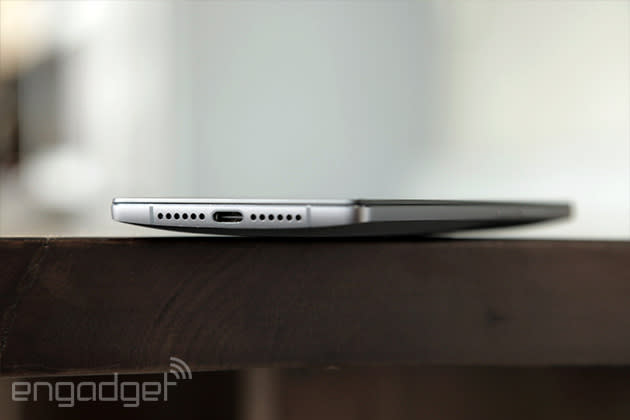
There's so much going on inside the OnePlus 2, in fact, that the designers clearly didn't feel the need to give it a brand-new look. What we got instead is a thoughtful refinement of the original's design that makes the whole thing feel more premium than its price tag suggests. To wit: The chassis itself is made of polycarbonate, but a magnesium and aluminum band runs around its sides, with drilled vents for the speaker and a USB Type-C charging port along the bottom. A quick look at the phone's left edge reveals something new: a three-stage notification slider that lets you select how obnoxious you want the phone to be when tweets, status updates and emails roll in. This is, in short, a revelation. It's a staggeringly useful addition, and other smartphone makers would do well to add something similar.
The most eye-catching addition is the fingerprint sensor that doubles as a home button. Pity that it's not as sensitive as it should be. It sometimes took multiple tries to unlock the phone with my finger (a reality, sadly, for just about any smartphone with biometric security) and you have to hit it with more force than you might expect. It's nice, in a way -- an ill-placed glancing blow won't disrupt your gaming sessions -- but I'd prefer more touch-pressure consistency between the home button and the two soft keys on either side of it.
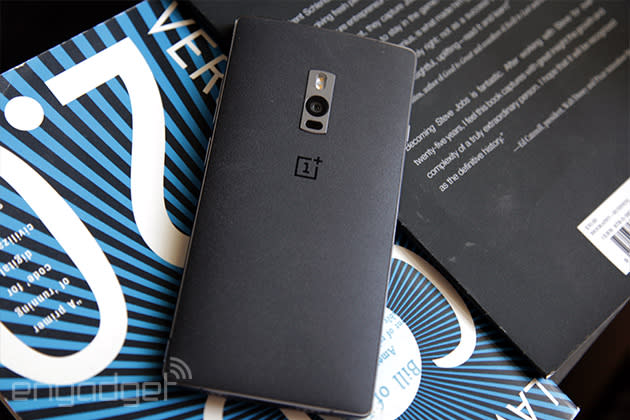
If you've played with the original model, the OnePlus 2's back will seem like a blast from the past. The changes here are pretty modest, and they mostly boil down to the fact that the 13-megapixel camera and dual-LED flash have been shifted south a few millimeters. This time, though, the camera itself is sandwiched between the flash and an LED autofocus module that promises to lock onto targets in as little as 0.2 second. My review unit came with the company's trademark sandstone black rear panel, which has been a point of contention among the people I've shown it too. Some (myself included) love the gritty, tactile feel of the sandstone finish because it's so drastically different from the glass-and-metal monoliths we usually play with, but it just left others scratching their heads. You can swap it out for bamboo, Kevlar, black apricot or rosewood covers for a little extra cash, and don't worry: It's much, much easier to remove this time around.
All told, OnePlus did a wonderful job putting its second-generation flagship killer together. It's light, but not too light, and there's not an iota of give when you start twisting the device (not that you should really do that in the first place). Between the OnePlus 2's handsome design, sturdy construction and Gorilla Glass 4 screen you've got a real looker that can stand up to even the silliest drunken drops. Just... trust me on that last bit.
Display and sound
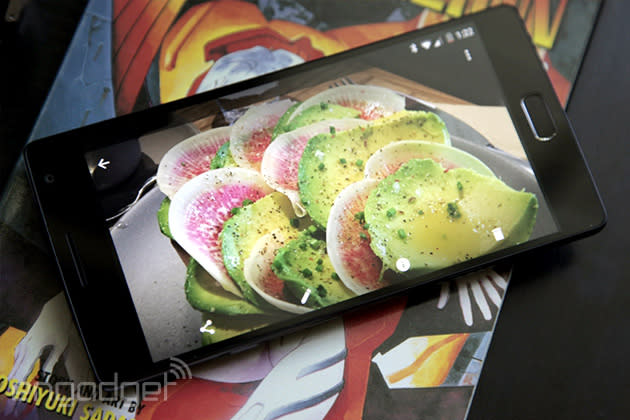
We're looking at yet another 5.5-inch, 1080p IPS LCD display this year, which means the same number of pixels squeezed into each linear inch as the original OnePlus One (that's 401 ppi, to be exact). The rest of the madding crowd might be embracing those gorgeous Quad HD panels, but really -- we're hardly worse off with a full HD screen here, especially considering the cost. I wouldn't be surprised if a few people reading this could somehow pick out individual pixels on the OP2's high-def screen. Well, I can't anyway, and the staggering majority of people can't, either. You're not missing out on anything.
As you might expect from an IPS screen, viewing angles are great even from odd positions (good news for over-the-shoulder screen peekers). Just don't expect the punchy colors you'd get from a Samsung phone's AMOLED display. I happen to like when my retinas are scorched by saturated screens, but the OnePlus 2's is considerably less in-your-face. Things are even cooler and subtler here than on the LG G4's "Quantum display," which strove for eye-catching color accuracy above all else. All told, it feels a little dull, a little lifeless, but I might be in the minority on this one. Still, those subdued colors also mean viewing the screen in direct sunlight can be tricky (though cranking up the brightness helps).
Meanwhile, the single speaker on the phone's bottom side does a fine job belting out tunes, although things can get muddled when you crank up the volume. OnePlus included the MaxxAudio equalizer app for good measure, and you can toggle it from the volume shade if you need some extra oomph. Honestly, the equalizer's effects are more noticeable -- and more valuable -- when you're using them in tandem with a pair of headphones. Just be careful when MaxxAudio is enabled; I couldn't get the volume up to 50 percent without feeling like I was thrashing my eardrums.
Software
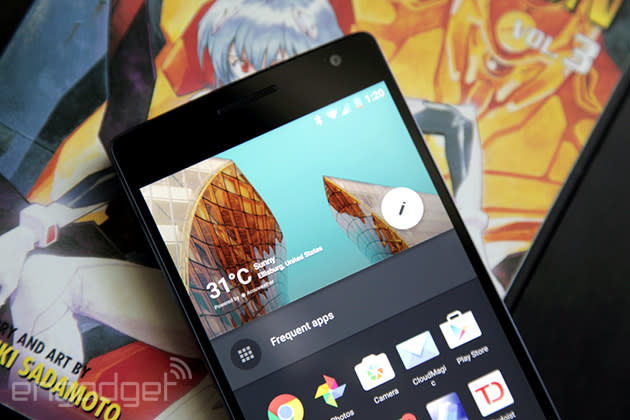
Before we go any further, a brief software note: Our OnePlus 2 is running a pre-release build (A2005_14_150807, if you're curious), and the company tells us an OTA update that's "close" to what I have is going live shortly.
Bon voyage, CyanogenMod. After a prolonged, public breakup (and at least one Taylor Swift joke), the OnePlus 2 comes loaded with a mostly clean version of Android 5.1.1 with just a handful of OnePlus' custom OxygenOS interface tweaks for added flavor. I really do mean "clean," too. As I mentioned earlier, my 64GB model had 53GB of storage ready for me to use out of the box, and just about all of that reserved space is taken up by Android proper. There are only two preloaded apps to be found here -- that MaxxAudio equalizer and SwiftKey's not-for-me keyboard -- and both can be disabled without much headache. Too bad you can't uninstall them. The rest is basically unfettered Lollipop and it looks and runs just as nicely as you'd expect it to.
Now we're left with those Oxygen tweaks, most of which are surprisingly useful. There's a dark theme if you're tired of Material Design's decided whiteness, and you can fire up some onscreen navigation keys if the insensitive physical home button really gets on your nerves. OnePlus also cribbed a few notes from Oppo with its onscreen gestures, so drawing a circle or a V on the display while the phone is off launches the camera and flashlight, respectively. Oh, and a double-tap on the screen will rouse the phone from slumber, a la LG's most recent G series devices. Perhaps the biggest question mark is the Shelf, which you can access by swiping right on your home screen. It puts your most frequently used apps and contacts in one place, and throws in your local weather report and some space for widgets down at the bottom. It's nice to have, I guess, but I've used the feature precisely zero times over the last week (unless you count the times I just showed people it was there).
Alas, not all is well with the OnePlus 2's software. Some third-party apps -- Todoist, Fenix, Falcon Pro, AquaMail, and Relay for Reddit, among others -- don't display properly because of a bug related to the way OxygenOS invokes Material Design's Light theme. Relay's probably the best, most publicized foul-up, as none of the comments on any Reddit post are visible, since they're rendered in white on a white background. Fenix and Falcon Pro, on the other hand, refuse to switch into their light themes. We're told that the team's working on a fix to be delivered in an update, but there's no public word on when that will arrive. Beyond those aesthetic issues, the OnePlus 2 is prone to random restarts; in fact, it happened while I was writing this very sentence. These random restarts happened about three times over the course of the week: twice while trying to launch the camera and once while it was just sitting on my desk charging. I'm really not sure what that's about; hopefully there's an update for that coming too. For what it's worth, OnePlus told us at least two OTA updates -- the one dropping now and another that seems focused on camera tweaks -- are coming, but wouldn't confirm whether the random reboots were fixed.
Camera
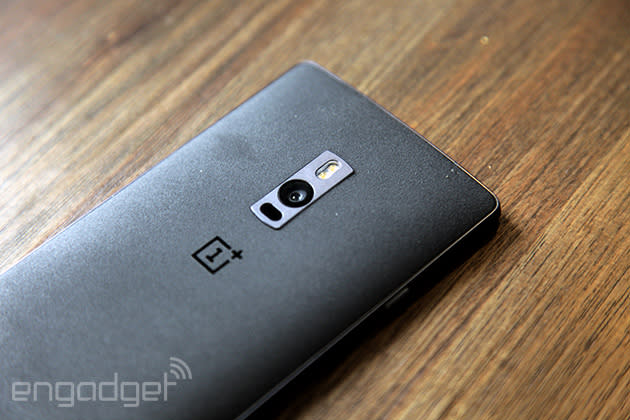
Last year's OnePlus One had a camera that didn't make for many thrills, so it's no surprise the team paid a little more attention to imaging and optics this time 'round. That 13-megapixel rear camera sensor sits behind an f/2.0 lens and it's better at sucking up photons because of its (relatively) large 1.3-micron pixel size. All that boils down to a mostly great shooting experience, especially when the sun's out or your lights are on. Just about all of my test photos had poppy, vibrant colors, along with plenty of detail.
Still, the camera shoots at a 4:3 aspect ratio so photos look a little odd on widescreen displays. It's surprisingly easy to get some good-looking shots while using the Auto mode, and OnePlus' controls are dead-simple. A quick tap of the shutter button snaps a photo, and you can fiddle with the exposure by tapping to focus on something and dragging a Sun icon around the focus ring. Swiping right lets you jump into video, panorama, slow-motion and time-lapse modes (all of which work exactly the way you'd expect), while a Clear Image mode stitches together multiple shots into one super-crisp photo. I wound up hardly ever using Clear Image, though, just because my normal photos usually came out looking great.
Smartphone cameras have a tendency to suck hard in low-light conditions, but the OnePlus 2 does a little better than you might expect. The autofocus (which normally works like a champ thanks to the laser module on the back) has a hard time doing its thing when your environs grow too dim, and after a while your photos come out murky and grainy. If your hand is steady enough, you can fire up the HDR mode to help mitigate some of these issues, but be prepared to see a bit of lag between shots while the phone processes your images. Really though, the steady hand trumps all; I managed to snap a sweet shot of the Ben Franklin Bridge without the help of HDR and didn't hate the results:

Performance and battery life
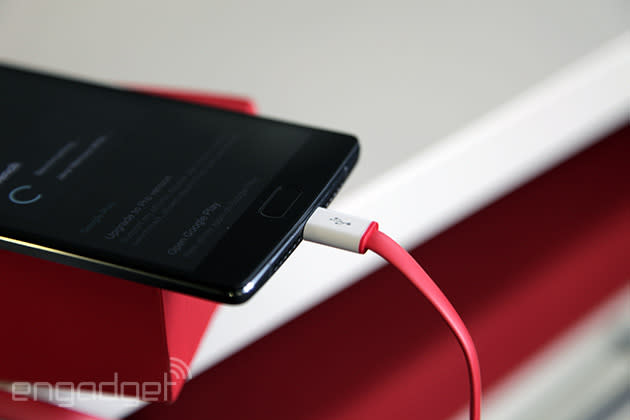
We can keep this bit relatively short: The OnePlus 2 moves with almost all the speed and fluidity you'd expect from a 2015 flagship phone. Qualcomm's octa-core Snapdragon 810 has gotten a bad rap since before day one because of its supposed overheating issues, but there's hardly any of that here -- just about everything runs incredibly smoothly, and games like Dead Trigger 2, The Talos Principle and Asphalt 8 never produced any hiccups, even at max graphics settings. Yes, you'll notice some warmth in the top half of the OnePlus 2's body during prolonged gaming sessions, but the sandstone cover seems to diffuse it nicely. All told, the heat was never unpleasant, per se. The reason I've been couching things with words like "almost" and "just about" is because I occasionally saw some apps take longer to launch than normal, if only by a second or two. It doesn't seem like cause for concern; I'd wager it's just a little Android flakiness and really, the issue sticks out more than it should because of how fast the phone is otherwise. Seriously, the OnePlus 2 brings the speed.
OnePlus 2 | Samsung Galaxy S6 | ZTE Axon | LG G4 | |
|---|---|---|---|---|
AndEBench Pro | 9,945 | 10,552 | 7,961 | 8,352 |
Vellamo 3.0 | 3,025 | 3,677 | 3,086 | 4,065 |
3DMark IS Unlimited | 23,598 | 21,632 | 24,802 | 18,572 |
SunSpider 1.0.2 (ms) | 1,516 | 674 | 1,489 | 725 |
GFXBench 3.0 1080p Manhattan Offscreen (fps) | 25 | 25 | 25 | 15 |
CF-Bench | 79,168 | 62,257 | 62,117 | 71,260 |
SunSpider 1.0.2: Android devices tested in Chrome; lower scores are better. | ||||
Now, about that battery. We're working with a sealed 3,300mAh cell here, and it stuck around for just over nine hours in the ol' Engadget rundown test (looping a video with WiFi on and the screen brightness set to 50 percent, in case you forgot). That puts the OnePlus 2 just ahead of both the Galaxy S6 and S6 Edge, but LG's G4 still wins with its 11-hour runtime. And mind you, that's with a smaller, removable battery and a Quad HD screen. I'd be concerned for your well-being if you just watched videos on a phone for nine hours without moving, and thankfully the OnePlus 2 fares even better when you're going about your day. On average, I've been able to get through a full 12-hour workday (with lots of Hangouts chatting and YouTube videos, plus the occasional game and work email) with 15 or 20 percent left in the tank. Most people will only have to charge their OnePlus 2's once a day, which is definitely a good thing -- there's no QuickCharge here so the USB Type-C connector takes longer to charge the phone than most other flagships.
The competition
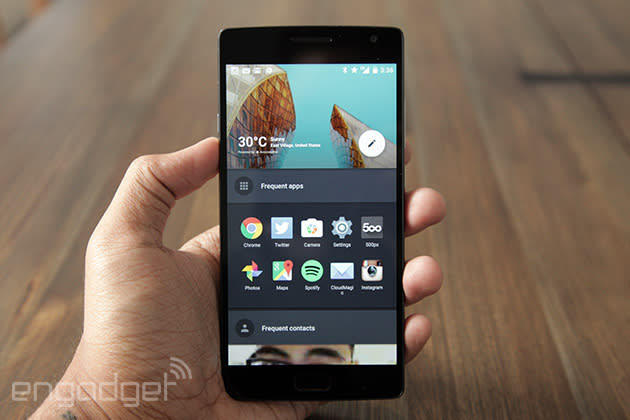
I've said it before, and I'll say it again: There's never been a better time to buy an unlocked smartphone. This year's crop of no-contract hardware has been first-rate, so keep these alternatives in mind before you make your decision. ZTE's $450 Axon threw me for a loop with its top-tier spec sheet and more-or-less clean version of Android. Audiophiles will dig its music-friendly software enhancements and performance tweaks, and the Quad HD display is pretty too, but be prepared to give yourself over to the cloud. There's only 32GB of internal storage and nary a memory card slot, an omission it shares with the OnePlus 2. I don't mind the lack of expandable memory as much as others do, but man: limiting users to only 32GB is pretty ridiculous. I'd recommend you stay away from the 16GB version of the OnePlus 2 as that's even more limited, but its $329 price is hard to argue with.
I'm also looking forward to seeing how the OP2 stacks up against Motorola's new $400 Moto X Pure, which pairs a hexa-core Snapdragon 808 with 3GB of RAM and a bigger 5.7-inch Quad HD screen. You'll be able to customize the dickens out of it once it launches, but that's not even the most important thing here. You see, software updates usually take ages to pass through carriers' rigorous testing and distribution processes. Motorola software chief Seang Chau told me this won't be the case, though: Since the company isn't going to sell the Pure edition through carriers, it has full control over how quickly it will receive new updates, as well as new versions of Android. Oh, and you won't have to scramble for an invite to buy one, either.
Wrap-up

OnePlus has plenty to be proud of. After all, the company managed to make a phone that improved on the already-excellent original in every way that mattered. The OnePlus 2 is a powerful, well-built device, offering the best blend of price and performance you'll find in an unlocked phone. The thing is, the version I tried is still haunted by a few pesky software issues that should be fixed soon. Maybe it's a good thing you haven't gotten your invite yet.
Even if we put aside these fixable software flaws, it's clear this phone won't be for everyone. No NFC means you won't be using it to make Android Pay payments when the service launches later this year. The lack of a memory card slot means you'll have to be careful about what you download or shoot. It's easy to forgive these shortcomings because of the price -- the trade-off is a worthy one in my book -- but competitors like the Moto X Pure Edition didn't have to compromise nearly as much. In the end, the OnePlus 2 is worth your cash if you're looking for a capable, powerful Android phone on the cheap, but you'd do well to wait a few weeks to see how the competition stacks up.































































